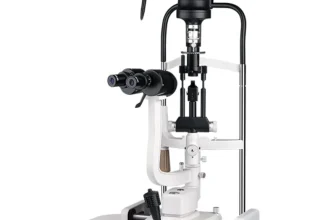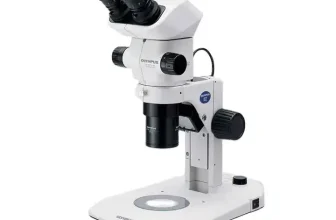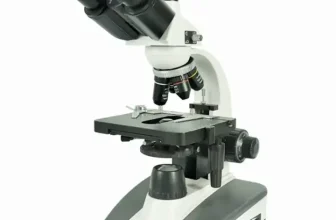Microscope LED lights are a revolutionary component that’s effectively advancing the microscopy field. LED stands for Light Emitting Diode and this type of lighting is used to illuminate the sample being viewed under the microscope. This technologically advanced form of lighting is known for its efficient and consistent illumination, low heat emission, and longevity in comparison to traditional microscope bulb options. High-quality LED lights in microscopes provide clear and crisp lighting that is vital for analyzing samples, assisting researchers, scientists, students, and hobbyists in attaining accurate observations and results.
Why is additional LED light important for a microscope
Adding an LED light to a microscope can significantly enhance the visibility and clarity of the specimen under examination. LED lights produce brighter, white light, which is more natural and comfortable for the human eye compared to the yellowish tint of halogen bulbs. This allows for more accurate color rendering and better contrast, which are crucial for detailed observation and analysis.
Furthermore, the light intensity of an LED can be easily adjusted, providing versatility for varying sample types and sizes. This additional light source also ensures an even distribution of light on the specimen, eliminating shadows and supporting a more thorough examination. Ultimately, LED lights offer a practical and effective solution to the challenges of poor lighting, thereby improving the overall microscopy experience.
Different types of Microscope Lights
Overview of Fluorescent light
Fluorescent lights announce their presence in science labs across the globe, silently contributing to countless breakthroughs. As a type of microscope light, fluorescent lamps offer a few distinct traits that set them apart. One of the most significant is the manner in which they produce light. Rather than being heated until it glows, as with halogen or incandescent lights, a fluorescent lamp creates light through a chemical reaction.
Just like any other light, it involves electrons and energy, but in a slightly more sophisticated way. In a fluorescent lamp, an electric current is passed through mercury vapor, and the resulting reaction gives off ultraviolet (UV) light. Unfortunately, our eyes cannot see UV light. To transform this UV radiation into visible light, the inner surface of the fluorescent lamp is coated with a phosphor material that fluoresces, or lights up, when it is hit by the UV light. This results in a soft, diffused light that is less intense than that of an LED or halogen lamp.
Fluorescent illumination has its virtues, most notably high quality contrast and long bulb life. Moreover, fluorescent lights generate less heat compared to other types of lights, making them a good fit for light-sensitive samples. However, there is a slight delay when they are switched on, and their light output decreases over time leading to a darker image. Lastly, fluorescent lights need a ballast to control the current, which can make them a little more cumbersome to use.
Despite these drawbacks, fluorescent light has been the goto choice for laboratories for many years, reflecting its reliability and the quality it offers. However, with the insurgence of modern LED light technology, there may be a shift in preferences on the horizon.
Overview of Halogen light
Halogen lighting is one of the most popular forms of illumination used in microscopy today. It is widely known for its bright, natural, and warm light. The light produced by a halogen bulb is due to the heating of a tungsten filament enclosed within a small quartz capsule filled with halogen gas. This interaction results in high-intensity lighting, perfect for discerning minute details in specimens.
In comparison to its contemporaries, halogen lights provide excellent color accuracy and a consistent light output. They generate a light spectrum that is closest to natural sunlight, thus enabling accurate color reproduction of samples. They are particularly conducive for detailed examinations or photography in microscopy.
However, halogen lights have their downsides too. They tend to generate a significant amount of heat, which may potentially harm sensitive specimens under extended observational periods. Moreover, the lifespan of halogen bulbs is shorter compared to LED lights, leading to frequent replacement needs. Halogen bulbs are also less energy-efficient, particularly on low settings, making LEDs a more environmentally friendly and cost-effective option.
Overview of LED Light
Benefits of LED lights
LED lights, or Light Emitting Diodes, have gained immense popularity in recent years, not just for their application in general lighting but also in special equipment like microscopes. LED lights offer an array of benefits that make them an attractive choice for microscopy.
First off, LED lights are known for their excellent brightness and intensity. This feature enables clear and detailed observations, no matter the level of magnification. Moreover, LED lights provide pure, white light, ensuring accurate color representation of the specimen under scrutiny.
Energy efficiency is another impressive feature of LED lights. They use considerable less power compared to traditional halogen lamps, thus being a cost-effective option in the long run. This is particularly critical in settings where the microscope is used intensively, such as laboratories and research facilities.
LED lights also have the advantage of a significantly long lifespan. They can function for up to thousands of hours without requiring replacement. This longevity translates to lowered maintenance cost and effort.
Lastly, LED lights do not generate as much heat as other types of lights. This not only makes for comfortable usage, especially for prolonged periods, but also protects delicate specimens from potential heat damage.
How they differ from other types
LED lights stand out from other microscope lights in various ways. Unlike fluorescent lights, they do not contain mercury, which can be harmful when disposed of irresponsibly. They are also more energy-efficient compared to both fluorescent and halogen lights, using a fraction of the power to deliver the same or even improved brightness. Moreover, LED lights generate much less heat than halogen lights, thereby minimizing the risk of damaging heat-sensitive specimens during observations. Another marked difference lies in their lifespan. LED lights outlast fluorescents and halogen lights, resulting in fewer replacements needed over time and making them a cost-effective lighting choice for microscopes in the long haul.
Installing a Microscope LED Light
Necessary tools for installation
Adding a LED light to your microscopy setup is an incredible enhancement that can drastically intensify your microscopic observations. Before diving into the installation process, it is pivotal to gather the necessary tools to ensure a seamless installation. Assembling the right tools beforehand will not only saves time but also makes the installation process fluid and effortless.
The required tools largely depend on the design of your microscope and the LED light kit you have opted for, but generally, you’ll need the following:
- Screwdriver Set: Microscope LED light installment may involve unscrewing small components on your microscope to fix the LED light in place. A good set of precision screwdrivers is useful for this purpose.
- Adjustable Wrench: An adjustable wrench can be handy for fixing or tightening certain parts of the LED light to the microscope.
- Wire Strippers: If any wiring or cables come unfitted or need adjustment for better compatibility, wire strippers might be used.
- Soldering Iron: In some instances, you may need to do a little bit of soldering to assure an excellent fit or connectivity between components.
- Safety Gloves and Glasses: While these aren’t a ‘tool’ as such, they are undeniably important for personal safety. Whether you’re handling tiny, sharp objects or soldering, safety should always be the top priority.
Remember, these are general tools that could be necessary based on the type of microscope and LED light you are handling. Always refer to the installation guide that comes with your LED light kit for specific tools needed and procedures to follow.
Step-by-step guide on how to install
Installing a Microscope LED light can seem a bit daunting initially but have no fear, this simple step-by-step guide will walk you through the process.
- Firstly, you will need to ensure that the microscope is turned off and unplugged. Safety is crucial when working with electronic devices.
- Identify the location for your LED light. This will typically be on the underside of the microscope, where the existing light source is located.
- Unscrew the housing or cover of the existing light source using the appropriate screwdriver. It is important to make sure you keep these screws safe, as you will need them to secure the LED light.
- Carefully remove the existing light source, taking care not to damage any of the other internal components.
- Insert the LED light into the designated location. LED lights are typically smaller and more adaptable than other types, making this a relatively straightforward process.
- Once the LED light is in place, secure it using the screws that were removed earlier.
- Before placing the cover back on, plug in the microscope and switch on the power. This is to test the LED light and ensure it’s functioning correctly.
- If the LED light is working as expected, switch off the power again, place the housing back on and secure it with the screws.
- The installation process is now complete. You can start using your microscope with its new LED light!
This guide is quite generic and may not apply to all microscope models. Always refer to the accompanying user manual before you start the process, and if you’re uncertain at any stage, consider seeking advice from a professional.
Key factors to consider when adding a Microscope LED Light
Brightness
Brightness is a crucial aspect to consider when adding a Microscope LED light. The level of brightness you need highly depends on the kind of microscopic work you’ll be carrying out. For intricate and detailed observations, a brighter light can make a world of difference, as it can significantly enhance visibility.
However, excessive brightness can distort the sample view and cause viewer discomfort. Hence, an LED light with adjustable brightness levels is a wise choice. As LEDs are commended for their adjustable intensity, they prove highly beneficial in minimizing user strain, especially during long hours of microscopic examination. Therefore, when choosing an LED light for your microscope, ensure you opt for one with a wide range of brightness level settings to provide the optimal viewing conditions for your specific needs.
Durability
Durability is a significant consideration when adding a Microscope LED Light. When investing in a microscope light, you’d want equipment that can withstand long working hours without breaking or that doesn’t need frequent replacement. LED lights win in the durability department because they are far more robust than traditional lighting options like halogen or fluorescent bulbs.
The solid structure of LED lights provides more resistance against external shock and vibration, making them less likely to be damaged during intense microscopic observation sessions or even during transport. Furthermore, since LED lights operate at lower temperatures than other types, they are less likely to overheat, which can also help extend their lifespan and maintain their functionality over time.
In summary, considering the durability of a Microscope LED Light is paramount to ensure the longevity of your lighting system for microscopic observations and thus, maximizing your investment.
Lifespan of the LED light
When considering the lifespan of the LED light for your microscope, it is important to understand that the LED lights have a significantly longer life compared to traditional forms of lighting such as halogen or fluorescent. LED lights are known to have an impressive lifespan ranging between 30,000 to 50,000 hours. Their long-lasting characteristic ensures that they do not need frequent replacements like other types, making them more cost-effective in the long run. However, factors such as heat and usage can have an impact on the lifespan of your LED light. So, while selecting, opt for high-quality LED lights as they assure a substantial life-span and consistent performance. It’s always better to consult the product specifications or ask the seller about the lifespan which can be different based on the brand or model of the LED light.
Cost
While LED lights can be slightly more expensive than traditional halogen or fluorescent lamps, it is important to note that their cost-effectiveness is far superior over the long term. Firstly, LEDs use significantly less energy which can result in substantial electricity savings over time, especially for those using microscopes frequently. Secondly, the extended lifespan of LED lights means the expenses related to replacements and maintenance are drastically reduced, offsetting the upfront cost. However, you must consider your budget and frequency of usage to decide if this investment would be beneficial for you. While selecting, do not overlook the long term monetary benefits for short term savings.
Maximizing the benefits of a Microscope LED Light
Tips on maintaining LED light
Maintaining the LED light of your microscope can significantly prolong its lifespan and maintain optimal function. Here are some noteworthy stipulations:
- Regular Cleaning: Dust and grime accumulated on your LED light might lead to reduced brightness and efficiency over time. To maintain the highest quality of light output, clean the LED light regularly with a soft, clean cloth. Be careful not to scratch the surface.
- Proper Usage: Avoid switching your microscope LED light on and off frequently in a short time span, as this might wear out the light’s components faster.
- Limit High Temperature Use: Long periods of operation at high brightness levels can cause the LED to overheat, affecting its lifespan. Allow the LED light to cool down after extended use.
- Proper Storage: When the microscope is not in use, store it in a cool, dry place to prevent any potential damage to the LED light due to moisture or extreme temperatures.
By adhering to these maintenance tips, you’ll ensure that your microscope LED light serves you efficiently for an extended length of time.
Proper adjustable brightness for various observations
Adjusting the brightness of your LED light source is paramount for various observations. This is heavily dependent on your specimen’s nature and the level of detail required for your study. Highly transparent samples may need lower light levels to avoid a washed-out image, while opaque or multi-layered samples may require brighter light for better visibility.
The beauty of using an LED light with your microscope is its versatility in brightness adjustment. Microscope LED lights provide a wide array of brightness levels. Allowing you to control the illumination according to your sample’s specific needs enhances the observable details and contrast in your images.
Remember, the key is to use just the right amount of light. Excessively high brightness may lead to damage in light-sensitive specimens and cause eyestrain for the observer. On the other hand, low brightness may obscure crucial details, negatively impacting the observation’s accuracy.
To balance, start with a lower light setting and slowly increase until you can clearly see the specimen’s details without discomfort. Moreover, some advanced microscope LED light systems come with an automatic brightness adjustment feature. This intelligent tool can adjust the brightness levels in real time according to the specimen, making your observation task even more comfortable and efficient.
Conclusion
Summarizing the advantages of adding a Microscope LED light
Opting for an additional LED light for your microscope brings forth numerous advantages, making it a clever upgrade worth considering. Firstly, the energy consumption of LED light is remarkably lower than the other two types of lights, namely, fluorescent and halogen. This translates into significant cost savings over the long run. Secondly, with the longevity that LED lights boast, you won’t need to worry about frequent replacement. There is also the key perk of improved control over the brightness level, as LED lights often include adjustable intensity settings to meet various observational requirements, giving you flexibility and precision. Lastly, the durability of LED lights ensures that they can withstand intensive and prolonged usage, making them an ideal choice for settings where the microscope is used frequently. The myriad of benefits makes LED lighting a popular choice and a worthwhile investment for those seeking enhanced microscope performance.
Call to action for readers to consider upgrading their microscope lighting
Moving forward with the wave of advanced technology is essential for everyone, especially those in the field of scientific study and exploration. Greater visibility and precision achieved by upgrading your microscope lighting to LED light can open new dimensions in your research. Now that you know the benefits of adding a microscope LED light such as increased brightness, durability, long lifespan, and cost-effectiveness, it’s time to make a change. Give your microscope the upgrade it deserves. Illuminate your discoveries with quality and distinction. Your observations, assessments, and research quality will thank you.







